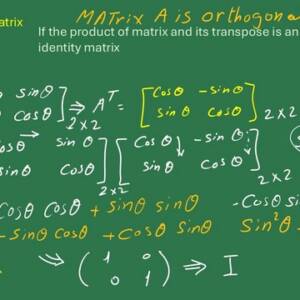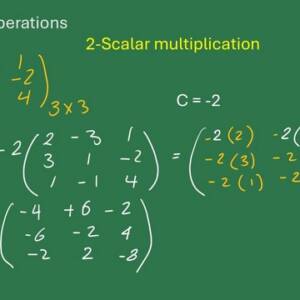Last Updated on March 24, 2025 by Maged kamel
Matrix operations-part-1, orthogonal matrix, addition, and subtraction.
What is the orthogonal matrix?
Orthogonal means perpendicular. An example of two orthogonal matrices is given for the value of matrix A and its transpose. For a given matrix A, written as ( cos θ sinθ, -sinθ cosθ), Its transpose can be formed by changing the rows into columns; the transpose will be ( cos θ -sinθ, sinθ cosθ). When multiplying both matrices, we will get an identity matrix. Please refer to post 2 to learn about the transpose of a matrix.

When are two matrices said to be equal? If we have, for instance, matrix B and matrix C., Then matrix B matrix C if each element of matrix B equals each element of matrix C, and both matrices should have the same dimension. For a given matrix A, if the value of a11=a, then the corresponding b11=3.
If both matrices B and C are (2×3), then matrix B equals matrix C, If a11=b11=3, also a12=-2=b12, which is x. When a11=b11=3, and also when a13=b=b13=-4, also if a22=c = b22 =-1, if c=-1.
There is an example of two matrices that have the same dimension but yet are not equal.

For these conditions, matrix B and matrix C are equal, or there will be equity between the two matrices.
Matrix operations-part-1.
Matrix addition & subtraction.
What are matrix operations? Adding matrices is the first operation of matrix operations part 1.
The first operation is adding two matrices or subtracting from each other. For example, we have matrix A (2×3) as shown) and another matrix B.
Both matrices must have (2×3). Then, we can add these two matrices. A+B is the new matrix from addition, and each element is determined by adding similar elements in matrix A and matrix B.
The first row with the first column=a11+b11=1+1=2 will be the first column’s new(A+B) matrix first row. Similarly, a21+b21=2+1=3 will be the new element for the second row with the first column.
The final matrix is shown due to the addition of A+B. For the value of the second row with the third column =(4+(-4)=0. The dimension f matrix (A+B) must be (2×3).
While subtracting matrix B from matrix A is the same as for the process of addition except that we add A+( -1*B) as if we multiplied matrix B by (-1),thenู (-1) the new elements of (-B) will be as(-1*1,+2*-1,1*-1, 1*-1, 3*-1, -4*-1).
We add to the corresponding elements in matrix A. The final form of (A-B) is shown.

As (0,-4,2,1,-4, 8). Here is a list of the operations that can be done for matrices. The first item is adding A+B, which will be=B+A.
If we have three matrices, A, B, and C, we will add them all. Adding A+(B+C) will give the same result as adding (A+B)+(C). Adding A+(-A)=0 is logical since all elements will be zeros. Adding A+0 will give matrix=A.
Scalar multiplication.
Scalar multiplication is the second operation of matrix operations part-1. It involves multiplying matrix A by a constant; the new matrix will be a multiple of the constant number. For the shown matrix 3×3, we want to multiply by 2.
The new matrix will have each element multiplied by 2 or twice the old matrix before multiplying.

Matrix multiplication.
Another operation is Matrix multiplication, which is the third operation of matrix operations part 1.
We draw an arrow from left to right and another from top to bottom. We must consider that the number of columns in the first matrix is the same as the number of rows in the other matrix.
We are multiplying a matrix of dimension(1×3) with another matrix (3×1). 1×3 means one row with three columns; 3 is common. The first three are the column numbers, and the others are the row numbers.

The dimension of the final matrix will be( 1×1), which is the product of the first element of matrix A by the last column dimension in the other matrix.
The final matrix dimension is to be(1×1), or only one element. The final number equals (2*1+3*4+5*-6), and added together will give 16. The new matrix dimension will be(1×1).
Press on any image, and you will see a slide show of pictures from 1 to 5, which are included above.





For a useful external link, math is fun for the matrix part.
This is a link to the next post, Matrix operations part -2.